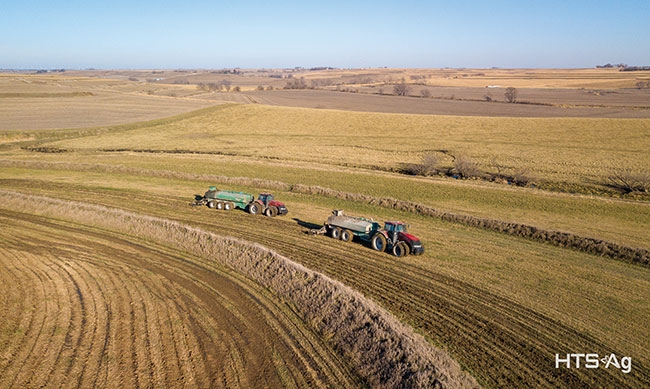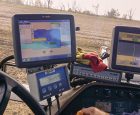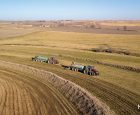
Equipment
Equipment
Manure Application
Proceeding with precision
What are the benefits of investing in and using precision application technology?
June 5, 2019 by Treena Hein
 Precision application technology often opens doors for custom applicators to offer important value-added services. Photo courtesy of Adam Gittins, HTS Ag.
Precision application technology often opens doors for custom applicators to offer important value-added services. Photo courtesy of Adam Gittins, HTS Ag.Early adaptors of precision application tools say there are numerous benefits that come with implementing the technology.
“I have a customer who installed variable rate control this fall and the benefits have been huge for him,” notes Paul Bruns, owner of Precision Consulting Services in Canby, Minn. “Once we analyzed his manure nutrient content and set him up with about $3,000 USD of equipment for precision application, he saw that the manure from his cattle that he normally would have spread over 300 acres, he should (and did) spread over about 1,200 acres. That’s how much nutrient value it had.”
Bruns adds that this farmer, “crunched the numbers and told me that he saved about $70,000 in fertilizer that he would have applied to those 900 acres next spring. That $3,000 he spent on equipment has already gained back more than 20 times over. It’s been great for his livestock as well as the grain side of his operation.”
Adam Gittins, general manager at HTS Ag in Harlan, Iowa, believes the true beauty of precision application technology is the ability to add it to existing machinery.
“With the slow economy the last few years, we can add a great deal of value to equipment by adding technology to it,” he says. “Instead of buying a new manure tanker that’s variable rate, a farmer can add a flow meter and log the rate of manure application, moving up to a variable rate system when they are ready. It really is a no-brainer.”
Gittins along with many other industry professionals agree that precision application is not as expensive, time-consuming or difficult to get started as many may think it is (check out page 18 for more details on implementing precision application technology).
“In the end, it’s about being as sure as you can of the value of your manure and optimizing that value,” Bruns says. “Farmers are ultimately after as many bushels as they can produce with as little cost as possible, and that’s what precision application provides.”
Additional benefits
Besides the incentive of protentional large, annual savings for little investment, the other major driver to get started with precision application technology, in Bruns’ and Gittins’ view, is staying ahead of regulatory requirements.
“Custom applicators in Iowa already have to submit a map generated by an automated system to meet state environmental regs,” Bruns notes. “I am proactive with my producers, trying to convince them that it’s better for them and for all farmers to show the regulatory bodies and the public that they are already doing precision application, that they are already applying the minimum amounts of fertilizer possible. I firmly believe that precision application will become a requirement over time, so why not get started now?”
Gittins agrees that precision application allows producers to address the regulation side of manure management. He says that the technology allows you to do a much better job at managing the nutrient side of crop management and also improves year-to-year farm management with records of how much was applied when and where, which helps to ensure all acres are rotated accurately and receive what they should.
Precision application technology often opens doors for custom applicators to offer important value-added services.
“Most custom applicators are just taking direction from farmers about how much to apply and where. They’re not doing a lot of the management components, and they could offer these extra services,” Bruns says. “Precision tech also allows them to provide their farmer customers with excellent records for their own use and for regulatory compliance. And it simplifies billing.”
Continued uptake
Gittins believes precision application technology is something that most producers across North America will be adopting very soon.
“It will make them better at what they do, and those who don’t use it will, in fact, be left behind,” he says. “It’s hard to say how soon everyone will have it, but within the next three to five years. These things are becoming standard.”
Bruns agrees that precision application is inevitable, but that he’s still seeing a lot of farmers who are interested but uncertain of the value and don’t have a lot of time to investigate it further.
“A lot of livestock guys are so caught up in day-to-day and they are concerned about this taking up more time and more dollars. But it is really life changing from a farm business perspective,” he asserts. “In every way, agronomically, economically and environmentally, you are able to manage your manure better and your farm better with precision application.”




